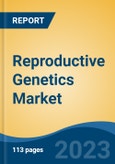Growing Reimbursement Improvements for Medical Tests and Initiatives, Running Parallel to Multiple Investments by Government Organizations for Developing New Diagnostic Centers, Have Significantly Increased the Demand for Reproductive Genetics Across Different Parts of the Globe.
Speak directly to the analyst to clarify any post sales queries you may have.
10% Free customizationThis report comes with 10% free customization, enabling you to add data that meets your specific business needs.
Increasing demand for Genetic Testing
Increasing demand for genetic testing of embryos, either during pregnancy or of those created through IVF to check for possible genetic disorders, is driving the growth of the reproductive genetics market. Increasing genetic testing for embryos through IVF technology and several developments in genetic testing are making it possible to test for genetic disorders in artificial reproduction, which is driving the market growth during the forecast period. Reproductive genetics help to identify embryo defects so that parents can adopt alternative procedures like IVF, thus increasing the healthy pregnancy and baby regardless of patient health, which will further boost the market during the forecast period. According to Statista, as of 2019, the leading state by the number of legal abortions in the United States was New York, which reported over 78 thousand abortions that year. Florida also reported over 71 thousand abortions, followed by Texas with over 57 thousand. There was a total of 630000 legal abortions in the United States in 2019.Growing Advancement in Genomic Technologies
Increasing advancement in genomic technologies and further implementation of these technologies in clinical medicine have enhanced their usage in the diagnosis of genetic disorders, carrier screening, and identification of the cause of infertility, propelling the market growth in the forecast period. Some tests are much more expensive, which helps couples from going ahead with the tests. However, with the decline in the cost of sequencing and the surge in the mixed-ethnicity population, an increasing number of couples/individuals are expected to opt for the new procedure, which is expected to drive the market growth during the forecast period. Birth defects affect one in every 33 babies (about 3% of all babies) born in the United States each year.Market Segmentation
The global reproductive genetics market can be segmented by component, technology, procedure type, application, and by region. Based on components, the market can be segmented into Laboratory Developed Tests, Kits & Assays, and Reagents & Consumables. Based on technology, the market can be segmented into Next Generation Sequencing, Polymerase Chain Reaction, In Situ Hybridization, and Microarrays. Based on procedure type, the market can be differentiated into Carrier Screening, Prenatal Screening, Preimplantation Genetic Testing, and Infertility Genetic Testing. Based on application, the market can be grouped into Aneuploidy, Single Gene Disorder, Structural Chromosomal Abnormality, and Others. Regionally, North America dominated the market among Asia Pacific, Europe, Middle East & Africa, and South America. Among the different countries, the United States dominated the global reproductive genetics market on account of the increasing demand for genetic testing to identify genetic abnormalities in the country.Recent Development
- In May 2021, Juno Diagnostics, Which is a company focusing on enhancing access to genetic health information, announced the closing of a Series A financing round for USD 25 million led by Perceptive Xontogeny Venture (PXV) Fund. The fund will support product development, clinical validation studies, and the commercial launch of JunoDx’s product offerings for non-invasive prenatal testing.
- In March 2020, Agilent Technologies announced the launch of three new microarrays for prenatal and postnatal research. The microarray includes updated clinically relevant content from respected databases. Progression of next-generation sequencing is uncovering new gene-disease associations, and databases are rapidly evolving to include these discoveries.
Market Players
CooperSurgical, Inc., Centogene AG, Invitae Corporation, Illumina, Inc., Myriad Genetics, Inc., Thermo Fisher Scientific Inc., Laboratory Corporation of America Holdings, Quest Diagnostics, Natera, Inc, Eurofins Scientific SE are some of the leading players operating in the Global Reproductive Genetics Market.Report Scope:
In this report, global reproductive genetics market has been segmented into the following categories, in addition to the industry trends, which have also been detailed below:Reproductive Genetics Market, By Component:
- Laboratory-Developed Tests
- Kits & Assays
- Reagents & Consumables
Reproductive Genetics Market, By Technology:
- Next-Generation Sequencing
- Polymerase Chain Reaction
- In Situ Hybridization, Microarrays
Reproductive Genetics Market, By Procedure Type:
- Carrier Screening
- Prenatal Screening
- Preimplantation Genetic Testing
- Infertility Genetic Testing
Reproductive Genetics Market, By Application:
- Aneuploidy
- Single Gene Disorder
- Structural Chromosomal Abnormality
- Others
Reproductive Genetics Market, By Region:
- North America
- United States
- Canada
- Mexico
- Europe
- France
- Germany
- United Kingdom
- Italy
- Spain
- Asia Pacific
- China
- India
- Japan
- South Korea
- Australia
- South America
- Brazil
- Argentina
- Colombia
- Middle East & Africa
- South Africa
- Saudi Arabia
- UAE
- Turkey
- Egypt
Competitive landscape
Company Profiles: Detailed analysis of the major companies present in Global Reproductive Genetics Market.Available Customizations:
With the given market data, the publisher offers customizations according to a company’s specific needs.This product will be delivered within 1-3 business days.
Table of Contents
Companies Mentioned (Partial List)
A selection of companies mentioned in this report includes, but is not limited to:
- CooperSurgical, Inc.
- Centogene AG
- Invitae Corporation
- Illumina, Inc.
- Myriad Genetics, Inc.,
- Thermo Fisher Scientific Inc.
- Laboratory Corporation of America Holdings
- Quest Diagnostics
- Natera, Inc
- Eurofins Scientific SE








